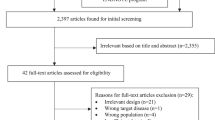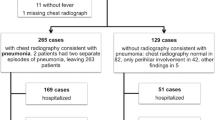Summary
We evaluated five previously published prediction models for radiographic pneumonia (Neuman, Oostenbrink, Lynch, Mahabee-Gittens, and Lipsett) using data from a single-center prospective study of patients 3 months to 18 years with signs of lower respiratory tract infection. Our outcome was radiographic pneumonia. We compared each model’s area under the receiver operating characteristic curve (AUROC) and evaluated their diagnostic accuracy at statistically-derived cutpoints.
Radiographic pneumonia was identified in 253 (22.2%) of 1142 patients. When using model coefficients derived from the study dataset, AUROC ranged from 0.58 (95% confidence interval, 0.52–0.64) to 0.79 (95% confidence interval, 0.75–0.82). When using coefficients derived from original study models, two studies demonstrated an AUROC >0.70 (Neuman and Lipsett); this increased to three after deriving regression coefficients from the study cohort (Neuman, Lipsett, and Oostenbrink). Two models required historical and clinical data (Neuman and Lipsett), and the third additionally required C-reactive protein (Oostenbrink). At a statistically derived cutpoint of predicted risk from each model, sensitivity ranged from 51.2% to 70.4%, specificity 49.9% to 87.5%, positive predictive value 16.1% to 54.4%, and negative predictive value 83.9% to 90.7%.
Prediction models for radiographic pneumonia had varying performance. The three models with higher performance may facilitate clinical management by predicting the risk of radiographic pneumonia among children with lower respiratory tract infection.
Similar content being viewed by others
References
Ramgopal S, Lorenz D, Navanandan N, et al. Validation of prediction models for pneumonia among children in the emergency department. Pediatrics. 2022;150:e2021055641.
Ramgopal S, Ambroggio L, Lorenz D, Shah SS, Ruddy RM, Florin TA. A prediction model for pediatric radiographic pneumonia. Pediatrics. 2022;149:e2021051405.
Lynch T, Platt R, Gouin S, Larson C, Patenaude Y. Can we predict which children with clinically suspected pneumonia will have the presence of focal infiltrates on chest radiographs? Pediatrics. 2004;113:e186–9.
Mahabee-Gittens EM, Grupp-Phelan J, Brody AS, et al. Identifying children with pneumonia in the emergency department. Clin Pediatr (Phila). 2005;44:427–35.
Neuman MI, Monuteaux MC, Scully KJ, Bachur RG. Prediction of pneumonia in a pediatric emergency department. Pediatrics. 2011;128:246–53.
Oostenbrink R, Thompson M, Lakhanpaul M, Steyerberg EW, Coad N, Moll HA. Children with fever and cough at emergency care: diagnostic accuracy of a clinical model to identify children at low risk of pneumonia. Eur J Emerg Med. 2013;20:273–80.
Lipsett SC, Hirsch AW, Monuteaux MC, Bachur RG, Neuman MI. Development of the novel pneumonia risk score to predict radiographic pneumonia in children. Pediatr Infect Dis J. 20221;41:24–30.
Phillips B, Wade R, Westwood M, Riley R, Sutton AJ. Systematic review and meta-analysis of the value of clinical features to exclude radiographic pneumonia in febrile neutropenic episodes in children and young people. J Paediatr Child Health. 2012;48:641–8.
World Health Organization. Revised WHO classification and treatment of childhood pneumonia at health facilities. Available from: https://apps.who.int/iris/bitstream/handle/10665/137319/9789241507813_eng.pdf. Accessed: 15 September 2022.
Scott JA, Wonodi C, Moïsi JC, et al. The definition of pneumonia, the assessment of severity, and clinical standardization in the Pneumonia Etiology Research for Child Health study. Clin Infect Dis. 2012;54:S109–16
Fitzner J, Qasmieh S, Mounts AW, et al. Revision of clinical case definitions: flu-like illness and severe acute respiratory infection. Bull World Health Organ. 2018;96:122–28
Cherian T, Mulholland EK, Carlin JB, et al. Standardized interpretation of paediatric chest radiographs for the diagnosis of pneumonia in epidemiological studies. Bull World Health Organ. 2005;83:353–9
Jain S, Williams DJ, Arnold SR, et al. Community-acquired pneumonia requiring hospitalization among U.S. children. N Engl J Med. 2015;372:835–45.
Mathew JL, Singhi S, Ray P, et al. Etiology of community acquired pneumonia among children in India: prospective, cohort study. J Glob Health. 2015;5:050418
Shah SN, Bachur RG, Simel DL, Neuman MI. Does This Child Have Pneumonia?: The Rational Clinical Examination Systematic Review. JAMA. 2017;318:462–471.
Arscott-Mills T, Boiditswe S, Chimfwembe D, et al. Chest Radiographic Findings and Out-comes of Pneumonia Among Children in Botswana. Pediatr Infect Dis J. 2016;35:257–62.
Hazir T, Nisar YB, Qazi SA, et al. Chest radiography in children aged 2–59 months diagnosed with non-severe pneumonia as defined by World Health Organization: descriptive multicentre study in Pakistan. BMJ. 2006;333:629.
Higdon MM, Chuananon S, Amorninthapichet T, et al. Etiology and Clinical Characteristics of Severe Pneumonia Among Young Children in Thailand: Pneumonia Etiology Research for Child Health (PERCH) Case-Control Study Findings, 2012–2013. Pediatr Infect Dis J. 2021;40:S91–S100.
Mwananyanda L, Thea DM, Chipeta J, et al. The Etiology of Pneumonia in Zambian Children: Findings From the Pneumonia Etiology Research for Child Health (PERCH) Study. Pediatr Infect Dis J. 2021;40:S40–S49.
Brooks WA, Zaman K, Goswami D, et al. The Etiology of Childhood Pneumonia in Bangladesh: Findings From the Pneumonia Etiology Research for Child Health (PERCH) Study. Pediatr Infect Dis J. 2021;40:S79–S90
Tapia MD, Sylla M, Driscoll AJ, et al. The Etiology of Childhood Pneumonia in Mali: Findings From the Pneumonia Etiology Research for Child Health (PERCH) Study. Pediatr Infect Dis J. 2021;40:S18–S28.
Howie SRC, Ebruke BE, McLellan JL, et al. The Etiology of Childhood Pneumonia in The Gambia: Findings From the Pneumonia Etiology Research for Child Health (PERCH) Study. Pediatr Infect Dis J. 2021;40:S7–S17.
O’Brien KL, Deloria Knoll M, Hammitt LL, Scott JAG. The Etiology of Pneumonia in HIV-uninfected Children in Kilifi, Kenya: Findings From the Pneumonia Etiology Research for Child Health (PERCH). Pediatr Infect Dis J. 2021;40:S29–S39.
Rees CA, Basnet S, Gentile A, et al. An analysis of clinical predictive values for radiographic pneumonia in children. BMJ Glob Health. 2020;5:e002708.
Lucero MG, Dulalia VE, Nillos LT, et al. Pneumococcal conjugate vaccines for preven-ting vaccine-type invasive pneumococcal disease and X-ray defined pneumonia in children less than two years of age. Cochrane Database Syst Rev. 2009;2009:CD004977.
Funding
Funding: None.
Author information
Authors and Affiliations
Corresponding author
Ethics declarations
Competing interests: None stated
Rights and permissions
About this article
Cite this article
Mathew, J.L. Prediction Models for Pneumonia Among Children in the Emergency Department. Indian Pediatr 59, 802–807 (2022). https://doi.org/10.1007/s13312-022-2623-1
Published:
Issue Date:
DOI: https://doi.org/10.1007/s13312-022-2623-1




